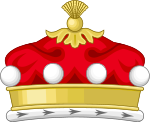
1st Baron de Saumarez
Baron de Saumarez, on the Island of Guernsey, is a title in the Peerage of the United Kingdom. [1] It was created on 15 September 1831 for the prominent naval commander Admiral Sir James Saumarez, 1st Baronet. He had already been created a Baronet, of Guernsey, on 13 June 1801. Lord de Saumarez was succeeded by his eldest son James, the second Baron, a clergyman. James was succeeded by his younger brother, John, the third Baron, whose son, the fourth Baron, was a career diplomat who bought the family estate at Castel, Guernsey, from his father, the third Baron, who wished to sell it. However, by marrying an heiress, the fourth Baron also brought estates in Suffolk into the family.
Contents
The family seat was at Castel in Guernsey from the time of the first baron until the fourth Baron died there in 1937. After the German occupation of the Channel Islands during the Second World War, the later barons lived mostly at their Shrubland Park estate, near Ipswich, in Suffolk. As of 2015 [update] the titles are held by the fourth Baron's great-grandson, the seventh Baron, who succeeded his father the sixth Baron in 1991. Although born and brought up in Suffolk, in April 2006, after the death of his mother, the present Lord de Saumarez sold Shrubland Park and settled in Guernsey.
Not be confused with Saumarez Park at Castel, the Sausmarez Manor estate at Saint Martin in Guernsey belongs to the senior line of the Sausmarez family, from which the Barons de Saumarez are descended. Matthew de Sausmarez (1718–1778), father of the first baron, was a younger brother of John de Sausmarez (1706–1774), of Sausmarez Manor.



